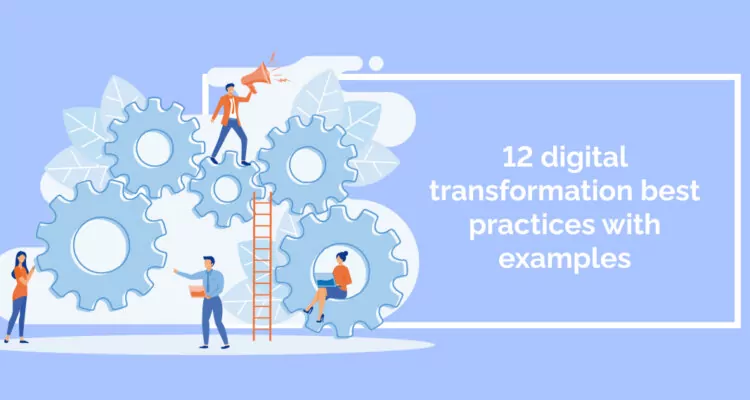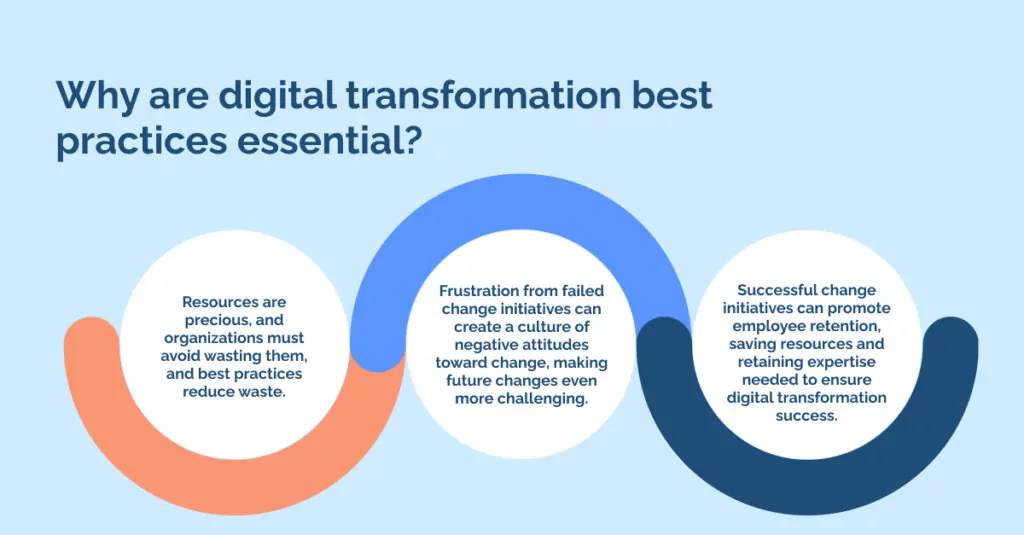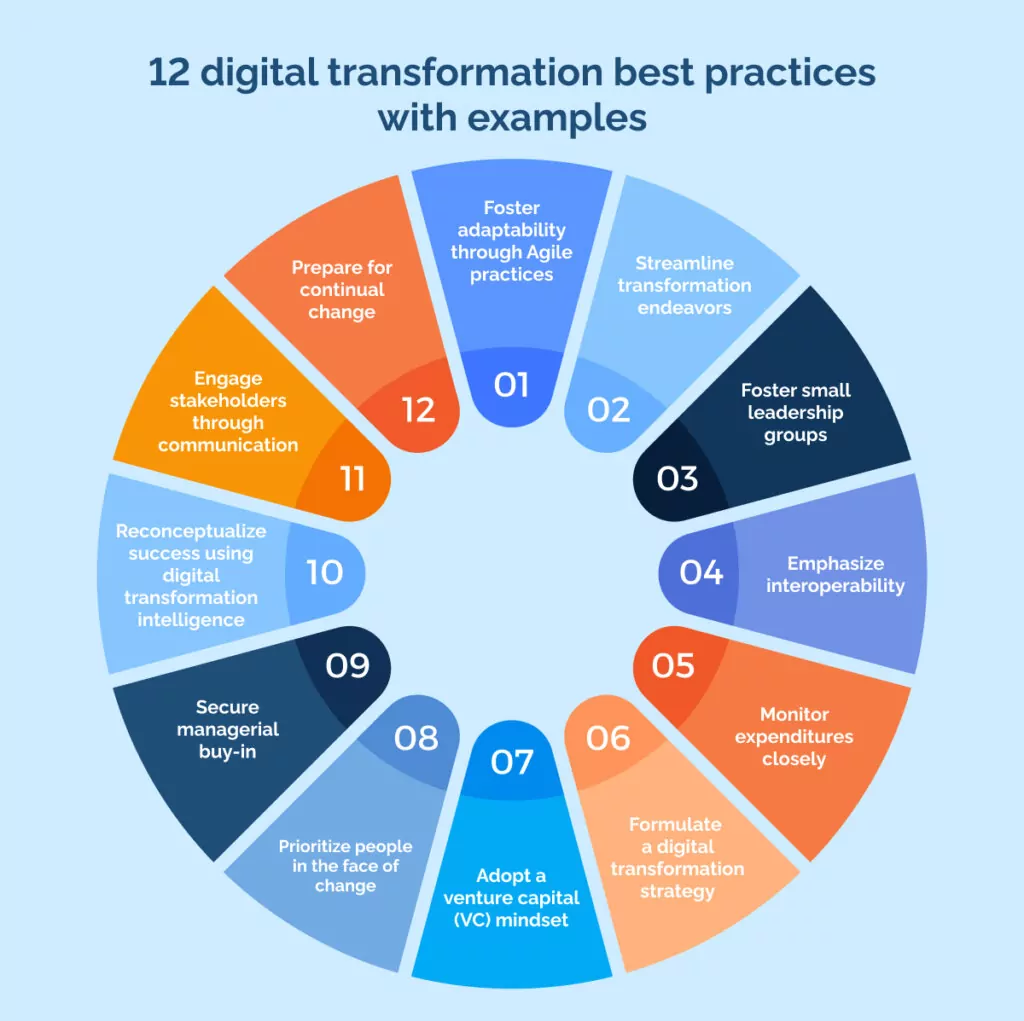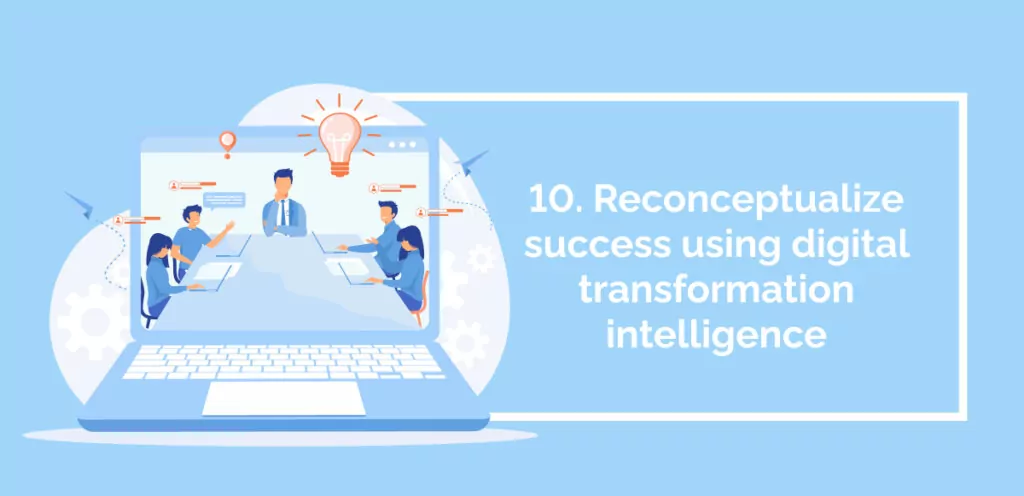
With generative AI and other digital technologies gaining faster traction than ever, successful digital transformation best practices are more critical now than at any additional time in history.
These best practices help guide leaders to successful digital transformation by keeping them focused on what they want to achieve, the challenges they may face, and how to resolve them for long-term success.
Using such best practices can help your organization avoid joining the two in three organizations in which digital transformations fail.
To help you, we will provide twelve digital transformation best practices to ensure success via the following topics:
- What are digital transformation best practices?
- Why digital transformation are best practices essential
- 12 digital transformation best practices with examples
What are digital transformation best practices?
Digital transformation best practices guide change leaders toward achieving the best outcomes for their digital transformation in the 21st century.
Digital Transformation in the 21st Century
These best practices are necessary because change is a complex and time-consuming process, so these best practices help leaders make the most efficient use of time and achieve goals, saving resources and reducing frustration for staff to make changes stick.
Why are digital transformation best practices essential?

There are three main reasons why best practices in digital transformation are essential to success, the first of which is the need to save resources.
- Resources are precious, and organizations must avoid wasting them, and best practices reduce waste.
- Frustration from failed change initiatives can create a culture of negative attitudes toward change, making future changes even more challenging.
- Successful change initiatives can promote employee retention, saving resources and retaining expertise needed to ensure digital transformation success.
Recall why these best practices are essential when implementing a digital transformation despite everything going wrong and causing you to wonder why best practices are worth your effort.
They help save money, reduce frustration, and retain staff; maintaining best practices during your digital transformation is always worth your energy.
12 digital transformation best practices with examples

Best practices help focus your efforts as change leadership to drive your organization toward innovation, success, and higher revenue, as staff at every level maintain motivation to succeed for all your change initiatives.
1. Foster adaptability through Agile practices

Agile methods initially emerged in software development but have gained traction in overseeing digital transformation efforts.
These methodologies advocate for incremental, phased development, allowing organizations to adapt to evolving technical demands and business requirements.
Examples
The Scaled Agile Framework is an excellent example of modifying Agile elements like Scrum for corporate applications, which aids business and technology leaders in navigating swiftly changing conditions.
2. Streamline transformation endeavors

Digital transformation initiatives are similar to the comprehensive systems integration programs of the 1980s and the business process reengineering endeavors of the 1990s.
Both often become cumbersome, resource-intensive, challenging to oversee, and lack tangible outcomes.
Contemporary transformation practitioners are breaking down initiatives into more manageable projects with swift turnarounds and accelerated time to value.
Agile methodologies benefit this context by emphasizing smaller initiatives over unwieldy, large-scale projects.
Examples
Japanese electronic company NEC streamlined its digital transformation by using a digital adoption platform equipped with in-app guidance to reduce SAP Ariba support tickets from staff by 75% when implementing new technology, driving a successful transformation.
3. Foster small leadership groups

Involving too many employees in the digital transformation process can impede progress.
Alternatively, organizations can nurture a more limited number of stakeholders closely connected to customers and vested in addressing a problem or capitalizing on a digital business opportunity.
Examples
The two-pizza rule, credited to Amazon founder Jeff Bezos, provides a principle: Maintain meeting attendance small enough that two large pizzas could suffice.
Smaller teams can navigate quicker, a valuable asset for the expedited rhythm of transformation.
4. Emphasize interoperability

A lack of interoperability can impede transformation.
This CIO challenge became more pronounced during the COVID era, as businesses rapidly acquired numerous cloud-based applications for digital operations.
While these SaaS acquisitions kept organizations operational, they compromised data sharing and system interaction.
The ensuing fragmentation impedes agility, giving rise to digital silos and disjointed business functions. Initiatives like application rationalization can streamline an organization’s IT architecture and minimize technical debt.
Additionally, organizations can initiate an integration program that ideally spans multiple departments and business functions.
Examples
A 2022 Accenture study found that high interoperability organizations increased revenue six times faster than their peers with low interoperability and are likely to unlock five extra percentage points in annual revenue growth.
5. Monitor expenditures closely

The imperative to swiftly transition to digital during COVID-19 led to an overabundance of cloud applications. Some organizations overlooked cost considerations when altering their business models.
This oversight proved problematic when inflation elevated, raising the costs of cloud services and other IT commodities.
Examples
Since the cloud is the backbone for most digital transformation endeavors, business and technology leaders must balance cost and innovation in leveraging this technological platform.
Many organizations resort to cloud cost optimization and adopt practices like FinOps, a cloud financial management discipline.
These endeavors aim to assist businesses in evaluating their cloud expenditure and identifying opportunities to minimize wastage.
6. Formulate a digital transformation strategy

Digital integration entails tackling various components and overcoming obstacles, from expenses to technical debt.
To navigate these challenges effectively, organizations should develop a digital transformation strategy.
This strategy outlines the vision for transformation, defines priorities, establishes goals for each phase of the initiative, and outlines a timeline for their achievement.
Examples
Assessment of your digital environment, creating a roadmap for the future, analyzing progress regularly, and adapting as needed to achieve a successful digital transformation strategy.
7. Adopt a venture capital (VC) mindset

Digital transformation hinges, in part, on leveraging technical innovation to support novel business processes, enhance efficiency, or gain a competitive advantage.
However, organizations contend with numerous emerging technologies and startup enterprises vying for attention.
Embracing a venture capital mindset, a CIO (chief information officer) or CTO (chief technology officer) establishes an idea pipeline akin to a VC’s deal pipeline.
Doing so may involve collaboration with a VC firm, industry consultant, or the company’s business development group to identify promising technologies and early-stage companies.
Business and technology leaders then compile a list of companies to evaluate for investment and proofs of concept.
The objective is to swiftly assess technology to seize a new development before competitors do. The VC mindset also prompts organizations to cultivate a greater tolerance for risk.
Examples
Within an enterprise portfolio of emerging technologies, such as generative AI, edge, and extended reality, there will be successes and setbacks to adopting the VC approach.
8. Prioritize people in the face of change

While staying abreast of new advancements is crucial, businesses could err by perceiving digital transformation solely as a technological endeavor.
Throughout the initiative, people must take center stage. If employees revert to familiar methods of task completion, the envisioned transformation might not materialize.
To avert this, an organization should cultivate a workforce capable of adapting to new work methodologies.
Do employees possess the requisite skillsets for success in a transformed environment?
It falls upon the CIO and other senior executives to ensure they do. Training, enablement, and change management programs can guide employees in embracing transformation and effectively utilizing new technology.
Examples
Change management models like ADKAR can help you focus on the experiences of your staff as they process every stage of change, helping them feel like the priority at all times.
9. Secure managerial buy-in

While employee participation fosters a buy-in conducive to enduring transformation, a commitment from top-level management is equally pivotal.
Active engagement from the C-suite elevates transformation to an enterprise priority, fostering the organizational change essential for transformation success.
Management is also responsible for outlining the transformation vision and endorsing the digital transformation strategy, ensuring the initiative attains the significance necessary for success.
Examples
Ensure management knows all updates in your organization’s digital transformation initiatives.
Additionally, make digital experiences engaging, fun, and familiar, and present managers to the rest of the organization as champions of change to get and keep managerial buy-in.
10. Reconceptualize success using digital transformation intelligence

What is Digital Transformation Intelligence?
Implementing organizational change necessitates a shift in behavior. Therefore, businesses must be ready to overhaul reward systems and performance metrics within a digital business initiative.
A company accustomed to recognizing incremental advancements must recalibrate its approach to incentivize the pursuit of transformational objectives.
Examples
An organization could reconceptualize success by offering a project team rewards for increasing the company’s revenue share derived from innovative products, making them role models for achievement to other staff.
11. Engage stakeholders through communication

An additional crucial determinant of success is maintaining the support of a business’ stakeholders throughout the digital transformation journey.
This action necessitates consistent and impactful communication throughout all digital initiatives.
Conducting periodic business reviews or health checks to evaluate the progress of a transformation effort fosters consensus and reiterates buy-in.
Leaders in transformation enhance transparency and credibility by openly addressing the impacts of change and evaluating whether an initiative is meeting anticipated outcomes.
Example
Apart from meetings, transformation teams can explore customer and user surveys to gather insights on the advantages and disadvantages of a transformation endeavor.
12. Prepare for continual change

Programs guiding teams must be ready to recalibrate transformation goals in the event of significant shifts in business conditions.
Instances like the rise of disruptive competitors or technologies could necessitate a shift in the direction of a digital initiative.
Example
Businesses should prepare for continual change by establishing a process for adjusting project goals, timelines, and outcomes, addressing the unexpected with a well-coordinated response rather than an impulsive reaction.
Commit to best practices to ensure digital transformation success
Achieving successful digital transformations might be a considerable challenge. Still, it is possible to increase your chances of success by following best practices to get maximum ROI from all your digital technology investments.
Commit to the best practices of planning, communication, and focusing on people as your top priority to steer your organization toward successful innovation, higher revenue, and a culture open to long-term change.
Tristan Ovington
Tristan Ovington is a professional senior writer and journalist, specializing in providing expert insights on various topics such as digital adoption, digital transformation, change management, and Cloud apps. He delivers his knowledge through accessible online content that is data-driven and presented in a friendly tone, making it easy for readers to understand and implement.



